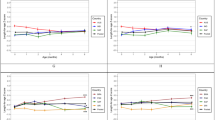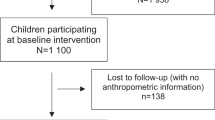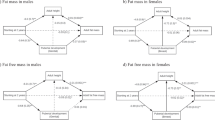Abstract
Background/objectives:
Growth parameters during infancy and early childhood might predict adipokine levels later in life. This study investigates the association between peak growth velocities, body mass index (BMI) and age at adiposity rebound (AR), with leptin and adiponectin levels at age 10 years.
subjects/Methods:
Peak height (PHV) and weight (PWV) velocities were calculated from height and weight measurements obtained between birth and age 2 years from 2880 children participating in the GINIplus (German Infant Nutritional Intervention plus environmental and genetic influences on allergy development) and LISAplus (Influences of Lifestyle-Related Factors on the Immune System and the Development of Allergies in Childhood plus Air Pollution and Genetics) birth cohorts. BMI and age at AR were calculated using BMI measurements between age 1.5 and 12 years. Blood samples were collected during a physical examination at age 10. Adiponectin and leptin levels were measured by radioimmunoassay. Linear regression models were fitted after adjustment for potential confounding factors and results are presented per interquartile range increase in the exposure.
Results:
Age at AR was negatively associated with leptin in males and females (percent difference β*: −41.71%; 95% confidence interval: (−44.34;−38.96) and β*: −43.22%; (−45.59; −40.75), respectively). For both males and females PWV (β*: 14.23%; (7.60; 21.26) and β*: 18.54%; (10.76; 26.87), respectively) and BMI at AR (β*: 63.08%; (55.04; 71.53) and β*: 67.02%; (59.30; 75.10), respectively) were positively associated with leptin levels. PHV showed a positive effect on leptin in females only (β*: 10.75%; (3.73; 18.25)). Growth parameters were not significantly associated with adiponectin except for age at AR among females (β: 0.75 ng/ml; (0.42; 1.09)) and PWV among males (β: 0.45 ng/ml; (0.11; 0.79)).
Conclusion:
Growth patterns in early life may be associated with leptin levels at age 10 years.
This is a preview of subscription content, access via your institution
Access options
Subscribe to this journal
Receive 12 print issues and online access
$259.00 per year
only $21.58 per issue
Buy this article
- Purchase on Springer Link
- Instant access to full article PDF
Prices may be subject to local taxes which are calculated during checkout


Similar content being viewed by others
References
Monteiro POA, Victora CG . Rapid growth in infancy and childhood and obesity in later life–a systematic review. Obes Rev 2005; 6: 143–154.
Gardner DSL, Hosking J, Metcalf BS, Jeffery AN, Voss LD, Wilkin TJ . Contribution of early weight gain to childhood overweight and metabolic health: a longitudinal study (EarlyBird 36). Pediatrics 2009; 123: e67–e73.
Koletzko B, Beyer J, Brands B, Demmelmair H, Grote V, Haile G et al. Early Influences of nutrition on postnatal growth. In: Gillman M, Gluckman P, Rosenfeld R (eds) Recent Advances in Growth Research: Nutritional, Molecular and Endocrine Perspectives. Karger: Basel, Switzerland, 2012, in press.
Druet C, Stettler N, Sharp S, Simmons RK, Cooper C, Smith GD et al. Prediction of childhood obesity by infancy weight gain: an individual-level meta-analysis. Paediatr Perinat Epidemiol 2012; 26: 19–26.
Botton J, Heude B, Maccario J, Ducimetière P, Charles MA, FLVS Study group. Postnatal weight and height growth velocities at different ages between birth and 5 y and body composition in adolescent boys and girls. Am J Clin Nutr 2008; 87: 1760–1768.
Mook-Kanamori DO, Durmus B, Sovio U, Hofman A, Raat H, Steegers EAP et al. Fetal and infant growth and the risk of obesity during early childhood: the Generation R Study. Eur J Endocrinol 2011; 165: 623–630.
Tzoulaki I, Sovio U, Pillas D, Hartikainen AL, Pouta A, Laitinen J et al. Relation of immediate postnatal growth with obesity and related metabolic risk factors in adulthood: the northern Finland birth cohort 1966 study. Am J Epidemiol 2010; 171: 989–998.
Silverwood RJ, De Stavola BL, Cole TJ, Leon DA . BMI peak in infancy as a predictor for later BMI in the Uppsala Family Study. Int J Obes (Lond) 2009; 33: 929–937.
Williams S, Davie G, Lam F . Predicting BMI in young adults from childhood data using two approaches to modelling adiposity rebound. Int J Obes Relat Metab Disord 1999; 23: 348–354.
Williams SM, Goulding A . Patterns of growth associated with the timing of adiposity rebound. Obesity (Silver Spring) 2009; 17: 335–341.
Ohlsson C, Lorentzon M, Norjavaara E, Kindblom JM . Age at Adiposity Rebound Is Associated with Fat Mass in Young Adult Males-The GOOD Study. PLoS One 2012; 7: e49404.
Kuo SM, Halpern MM . Lack of association between body mass index and plasma adiponectin levels in healthy adults. Int J Obes (Lond) 2011; 35: 1487–1494.
Giapros V, Evagelidou E, Challa A, Kiortsis D, Drougia A, Andronikou S . Serum adiponectin and leptin levels and insulin resistance in children born large for gestational age are affected by the degree of overweight. Clin Endocrinol (Oxf) 2007; 66: 353–359.
Phillips DI, Fall CH, Cooper C, Norman RJ, Robinson JS, Owens PC . Size at birth and plasma leptin concentrations in adult life. Int J Obes Relat Metab Disord 1999; 23: 1025–1029.
Lissner L, Karlsson C, Lindroos AK, Sjöström L, Carlsson B, Carlsson L et al. Birth weight, adulthood BMI, and subsequent weight gain in relation to leptin levels in Swedish women. Obes Res 1999; 7: 150–154.
Larnkjaer A, Schack-Nielsen L, Mølgaard C, Ingstrup HK, Holst JJ, Michaelsen KF . Effect of growth in infancy on body composition, insulin resistance, and concentration of appetite hormones in adolescence. Am J Clin Nutr 2010; 91: 1675–1683.
von Berg A, Koletzko S, Gruebl A, Filipiak-Pittroff B, Wichmann HE, Bauer CP et al. The effect of hydrolyzed cow’s milk formula for allergy prevention in the first year of life: the German Infant Nutritional Intervention Study, a randomized double-blind trial. J Allergy Clin Immunol 2003; 111: 533–540.
von Berg A, Koletzko S, Filipiak-Pittroff B, Laubereau B, Gruebl A, Wichmann HE et al. Certain hydrolyzed formulas reduce the incidence of atopic dermatitis but not that of asthma: three-year results of the German Infant Nutritional Intervention Study. J Allergy Clin Immunol 2007; 119: 718–725.
Heinrich J, Bolte G, Hölscher B, Douwes J, Lehmann I, Fahlbusch B et al. Allergens and endotoxin on mothers’ mattresses and total immunoglobulin E in cord blood of neonates. Eur Respir J 2002; 20: 617–623.
Zutavern A, Rzehak P, Brockow I, Schaaf B, Bollrath C, von Berg A et al. Day care in relation to respiratory-tract and gastrointestinal infections in a German birth cohort study. Acta Paediatr 2007; 96: 1494–1499.
Simondon KB, Simondon F, Delpeuch F, Cornu A . Comparative study of five growth models applied to weight data from congolese infants between birth and 13 months of age. Am J Hum Biol 1992; 4: 327–335.
Flexeder C, Thiering E, Brüske I, Koletzko S, Bauer CP, Wichmann HE et al. Growth velocity during infancy and onset of asthma in school-aged children. Allergy 2012; 67: 257–264.
Berkey CS, Reed RB . A model for describing normal and abnormal growth in early childhood. Hum Biol 1987; 59: 973–987.
Sovio U, Mook-Kanamori DO, Warrington NM, Lawrence R, Briollais L, Palmer CNA et al. Association between common variation at the FTO locus and changes in body mass index from infancy to late childhood: the complex nature of genetic association through growth and development. PLoS Genet 2011; 7: e1001307.
Butte NF, Garza C, de Onis M . Evaluation of the feasibility of international growth standards for school-aged children and adolescents. J Nutr 2007; 137: 153–157.
R Development Core Team. R: A Language and Environment for Statistical Computing. Vienna, Austria, 2012, ISBN 3-900051-07-0.
Ong KK, Frystyk J, Flyvbjerg A, Petry CJ, Ness A, Dunger DB . Sex-discordant associations with adiponectin levels and lipid profiles in children. Diabetes 2006; 55: 1337–1341.
Kuzawa CW . Adipose tissue in human infancy and childhood: an evolutionary perspective. Am J Phys Anthropol 1998; 41 (Suppl 27), 177–209.
Soriguer Escofet FJ, Esteva de Antonio I, Tinahones FJ, Pareja A . Adipose tissue fatty acids and size and number of fat cells from birth to 9 years of age–a cross-sectional study in 96 boys. Metabolism 1996; 45: 1395–1401.
Zimmet P, Hodge A, Nicolson M, Staten M, de Courten M, Moore J et al. Serum leptin concentration, obesity, and insulin resistance in Western Samoans: cross sectional study. BMJ 1996; 313: 965–969.
Iñiguez G, Soto N, Avila A, Salazar T, Ong K, Dunger D et al. Adiponectin levels in the first two years of life in a prospective cohort: relations with weight gain, leptin levels and insulin sensitivity. J Clin Endocrinol Metab 2004; 89: 5500–5503.
Kim CS, Park JS, Park J, Nam JS, Kang ES, Ahn CW et al. Does birthweight predict adolescent adiponectin levels? Clin Endocrinol (Oxf) 2006; 64: 162–168.
Ong KK, Ahmed ML, Sherriff A, Woods KA, Watts A, Golding J et al. Cord blood leptin is associated with size at birth and predicts infancy weight gain in humans. ALSPAC Study Team. Avon Longitudinal Study of Pregnancy and Childhood. J Clin Endocrinol Metab 1999; 84: 1145–1148.
Cianfarani S, Martinez C, Maiorana A, Scirè G, Spadoni GL, Boemi S . Adiponectin levels are reduced in children born small for gestational age and are inversely related to postnatal catch-up growth. J Clin Endocrinol Metab 2004; 89: 1346–1351.
Tamakoshi K, Yatsuya H, Wada K, Matsushita K, Otsuka R, Sugiura K et al. Low birth weight is associated with reduced adiponectin concentration in adult. Ann Epidemiol 2006; 16: 669–674.
Ong KK . Early determinants of obesity. Endocr Dev 2010; 19: 53–61.
Ostlund R Jr, Yang JW, Klein S, Gingerich R . Relation between plasma leptin concentration and body fat, gender, diet, age, and metabolic covariates. J Clin Endocrinol Metab 1996; 81: 3909–3913.
Lecke SB, Morsch DM, Spritzer PM . Leptin and adiponectin in the female life course. Braz J Med Biol Res 2011; 44: 381–387.
Böttner A, Kratzsch J, Müller G, Kapellen TM, Blüher S, Keller E et al. Gender differences of adiponectin levels develop during the progression of puberty and are related to serum androgen levels. J Clin Endocrinol Metab 2004; 89: 4053–4061.
Pei Z, Flexeder C, Fuertes E, Thiering E, Koletzko B, Cramer C et al. Early life risk factors of being overweight at 10 years of age: results of the German birth cohorts GINIplus and LISAplus. Eur J Clin Nutr 2013; 67: 855–862.
Angbratt M, Ekberg J, Walter L, Timpka T . Prediction of obesity from infancy to adolescence. Acta Paediatr 2011; 100: 1249–1252.
Taylor RW, Goulding A, Lewis-Barned NJ, Williams SM . Rate of fat gain is faster in girls undergoing early adiposity rebound. Obes Res 2004; 12: 1228–1230.
Plachta-Danielzik S, Gehrke MI, Kehden B, Kromeyer-Hauschild K, Grillenberger M, Willhöft C et al. Body fat percentiles for German children and adolescents. Obes Facts 2012; 5: 77–90.
Holm JC, Gamborg M, Kaas-Ibsen K, Gammeltoft S, Ward L, Heitmann BL et al. Time course and determinants of leptin decline during weight loss in obese boys and girls. Int J Pediatr Obes 2007; 2: 2–10.
Holm JC, Gamborg M, Ward LC, Gammeltoft S, Kaas-Ibsen K, Heitmann BL et al. Tracking of leptin, soluble leptin receptor, and the free leptin index during weight loss and regain in children. Obes Facts 2011; 4: 461–468.
Holm JC, Gamborg M, Ward L, Ibsen KK, Gammeltoft S, Sørensen TIA et al. Longitudinal analysis of leptin variation during weight regain after weight loss in obese children. Obes Facts 2009; 2: 243–248.
Sattar N, Wannamethee G, Sarwar N, Chernova J, Lawlor DA, Kelly A et al. Leptin and coronary heart disease: prospective study and systematic review. J Am Coll Cardiol 2009; 53: 167–175.
Sattar N, Wannamethee G, Sarwar N, Tchernova J, Cherry L, Wallace AM et al. Adiponectin and coronary heart disease: a prospective study and meta-analysis. Circulation 2006; 114: 623–629.
Wannamethee SG, Shaper AG, Whincup PH, Lennon L, Sattar N . Adiposity, adipokines, and risk of incident stroke in older men. Stroke 2013; 44: 3–8.
Cao JJ . Effects of obesity on bone metabolism. J Orthop Surg Res 2011; 6: 30.
Vega GL, Grundy SM . Metabolic risk susceptibility in men is partially related to adiponectin/leptin ratio. J Obes 2013; 2013: 409679.
Acknowledgements
The GINIplus study was funded by Helmholtz Zentrum München and grants of the Federal Ministry for Education, Science, Research and Technology 292 (Grant No. 01 EE 9401-4), the 6 and 10 years follow-up of the GINIplus study was partly funded by the Federal Ministry of Environment (IUF, FKZ 20462296). This study was supported by Ludwig Maximilians University’s innovative research priority project MC Health (subproject I). The LISAplus study was funded by Helmholtz Zentrum München, Munich Center of Health (MC Health) and partly by grants of the Federal Ministry of Environment (BMU) (for IUF, 298 FKZ 20462296) and Federal Ministry for Education, Science, Research and Technology (No. 01 EG 9705/2 and 01 EG 9732). This work was supported by the Kompetenznetzwerk Adipositas (Competence Network Obesity) funded by the Federal Ministry of Education and Research (FKZ 01GI1121A). We thank Elaine Fuertes for editing the manuscript.
Author information
Authors and Affiliations
Consortia
Corresponding author
Ethics declarations
Competing interests
The authors declare no conflict of interest.
Additional information
Supplementary Information accompanies this paper on European Journal of Clinical Nutrition website
Supplementary information
Appendices
Appendix: GINIplus Study Group
Helmholtz Zentrum München, German Research Center for Environmental Health, Institute of Epidemiology I, Munich (Heinrich J, Wichmann HE, Sausenthaler S, Zutavern A, Chen CM, Schnappinger M and Rzehak P); Department of Pediatrics, Marien-Hospital, Wesel (Berdel D, von Berg A, Beckmann C and Gross I); Department of Pediatrics, Ludwig Maximilians University, Munich (Koletzko S, Reinhardt D and Krauss-Etschmann S); Department of Pediatrics, Technical University, Munich (Bauer CP, Brockow I, Grübl A and Hoffmann U); IUF–Leibniz Research Institute for Environmental Medicine, Düsseldorf (Krämer U, Link E and Cramer C); Center for Allergy and Environment, Technical University, Munich (Behrendt H).
LISAplus Study Group
Helmholtz Zentrum München, German Research Center for Environmental Health, Institute of Epidemiology I, Munich (Heinrich J, Wichmann HE, Sausenthaler S, Chen CM and Schnappinger M); Department of Pediatrics, Municipal Hospital ‘St Georg’, Leipzig (Borte M and Diez U); Marien-Hospital Wesel, Department of Pediatrics, Wesel (von Berg A, Beckmann C and Gross I); Pediatric Practice, Bad Honnef (Schaaf B); Helmholtz Centre for Environmental Research–UFZ, Department of Environmental Immunology/Core Facility Studies, Leipzig (Lehmann I, Bauer M, Gräbsch C, Röder S and Schilde M); University of Leipzig, Institute of Hygiene and Environmental Medicine, Leipzig (Herbarth O, Dick C and Magnus J); IUF–Leibniz Research Institute for Environmental Medicine, Düsseldorf (Krämer U, Link E and Cramer C); Technical University Munich, Department of Pediatrics, Munich (Bauer CP and Hoffmann U); ZAUM–Center for Allergy and Environment, Technical University, Munich (Behrendt H, Grosch J and Martin F).
Rights and permissions
About this article
Cite this article
Flexeder, C., Thiering, E., Kratzsch, J. et al. Is a child’s growth pattern early in life related to serum adipokines at the age of 10 years?. Eur J Clin Nutr 68, 25–31 (2014). https://doi.org/10.1038/ejcn.2013.213
Received:
Revised:
Accepted:
Published:
Issue Date:
DOI: https://doi.org/10.1038/ejcn.2013.213
Keywords
This article is cited by
-
Earlier BMI rebound and lower pre-rebound BMI as risk of obesity among Japanese preschool children
International Journal of Obesity (2018)
-
Epidemiology in Germany—general development and personal experience
European Journal of Epidemiology (2017)



